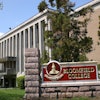Now that the court has ruled against the use of statistical
sampling, the U.S. Census Bureau looks to the minority higher education
community for assistance
As a Ph.D. student in economics, Daniel Muhammad is accustomed to
using U.S. census data to support the economic development research he
conducts for Howard University’s Center for Urban Progress.
Muhammad has found that census data describing the education,
income, and employment profiles of people living in the communities
surrounding the Washington, D.C., campus is helping him devise economic
strategies tailored to their situation.
“I’ve been looking at economic activity that would be most
beneficial for the community based on the employment status and
educational level of residents there,” Muhammad says.
Although Muhammad admits that data from the 1990 census is becoming
outdated for his research, he says U.S. census statistics represent, by
far, the most comprehensive information accumulated on urban
communities such as the majority-Black neighborhoods near Howard.
“There’s a tendency among community advocates to throw out ideas
without the research to back and support them. The census data helps to
explain the character of a community. And the better picture you have,
the better results will be with economic development efforts,” Muhammad
says.
After the year 2000, researchers, such as Muhammad, and others will
have results of a new census. In the view of many, demographic
information on low-income and working-class urban communities can
empower community activists, public officials, and residents with the
information to lure economic development and secure social services.
Researchers and administrators at colleges and universities based in
racially and ethnically diverse urban communities know all too well the
impact that census data has on those populations.
“It’s the most important body of data that we have,” Dr. Ronald
Walters, political science professor at the University of
Maryland-College Park, says of the census.
As the U.S. population approaches 300 million, the census in 2000
will be the largest ever undertaken in American history. Yet, if trends
in undercounting minority and primarily urban populations from the past
two censuses continue, the flawed data from urban Black, Hispanic, and
Asian communities will have far-reaching and negative consequences. If
an undercount in minority communities occurs at a rate comparable to
the censuses in 1980 and 1990, the 2000 census will cause those
communities to lose out on hundreds of millions of dollars in federal
aid and resources.
“A high census undercount hurts the people who need the assistance
most,” says Dr. Robert Hill, director of the Institute for Urban
Research at Morgan State University.
A high undercount also impairs the ability of researchers and
institutions to do quality research on minority populations, and it
undercuts advocacy efforts on behalf of communities in need. Walters
says that while census data has detailed information on minority
communities, “for some purposes, the census data is regarded as
problematic.”
In 1990, the Census Bureau undercounted African Americans and
Hispanics at five times the rate it bypassed Whites. The bureau
reported that it missed 8.4 million people in that census, and
double-counted 4.4 million others.
An Unacceptable Method
Like many of their colleagues, Hill and Walters have favored the
Census Bureau’s plans to use a method called scientific sampling to
improve accuracy in the 2000 census. A substantial body of researchers,
academics, public officials (including the Clinton Administration),
civil rights activists, and organizations (such as the National Academy
of Sciences and the American Statistical Association) support the use
of sampling because they believe it will produce a more accurate
census. They have argued that a more accurate census will lead to
better government planning, more fair allocation of public resources.
“What is at stake here is the ability of the Census Bureau to use
the most modern scientific methods to ensure an accurate and fair
census,” according to William M. Daley, Secretary of the U.S.
Department of Commerce.
Supporters of scientific sampling experienced a disappointing blow
when a three-judge federal court in Washington, D.C., ruled in late
August that sampling is illegal. The decision was hailed by opponents
of sampling, many of whom are congressional Republicans and political
conservatives.
“The unanimous decision is a tremendous victory for every American.
The Clinton administration’s illegal and unconstitutional scheme to
manipulate our census for the express purposes of political gain has
been exposed,” House Speaker Newt Gingrich (R-Ga.) told reporters.
Clinton Administration and Census Bureau officials announced they will appeal the decision to the U.S. Supreme Court.
“We will ask the Solicitor General to appeal the ruling and we
expect the Supreme Court to reverse it. Meantime, the Census Bureau
will proceed with its two-track planning process, preparing for both a
census using an element of statistical sampling, and a census that
would not use those methods,” Daley said.
Plans to use scientific sampling in Census 2000 appeared after
Congress, in the aftermath of the 1990 census, directed the Census
Bureau to accomplish two goals. First, the agency was told to reduce
the undercount — which increased from 1.2 percent of the population in
1980 to 1.8 percent in 1990 — and place special emphasis on
eliminating the higher undercount of groups such as African Americans
and Hispanics. Second, Congress ordered the Census Bureau to keep
census costs down.
Sampling, a statistical technique that reaches conclusions about a
population derived from a sample within that target population, would
be used to estimate the population of the people who are hardest to
count. The target population, in the case of Census 2000, would be
determined after 90 percent of the nation is counted using traditional
enumeration methods. The remaining 10 percent, which includes the
people who are hardest to reach, will be the target population.
Bureau officials say a form of sampling is used once traditional
enumeration efforts to count households have been exhausted.
Traditionally, questionnaires are sent to households. The occupants, in
turn, complete and return them to the bureau. The Census then sends
enumerators to count people in households that fail to return
questionnaires.
`The Results of Not Estimating Well’
The proposal for the more extensive use of sampling has drawn
staunch opposition from congressional Republicans, who have threatened
to block funding for sampling in Census 2000. Republican members of
Congress filed two lawsuits in federal court, including the one decided
in August, to block the use of statistical sampling in Census 2000.
Proponents of sampling say opposition to it is rooted in the
unstated notion that a highly accurate census will lead to the creation
of additional congressional districts which will have majority minority
populations, thus likely increasing the numbers of Democratic
representatives in Congress.
The Census is used to determine congressional reapportionment.
Legislative districts at the state, county and city levels also are
shaped according to Census data.
Hill, who advises the Bureau on gathering information about
minority communities, has done extensive research on the effects of
census undercounting. In a report, titled Financial Impact of the 1990
Census Undercount on Selected States and Cities, Hill documented that
New York City was losing $325 million a year in government funding;
Washington, D.C., lost $91 million annually in government revenues; and
Detroit had lost $25 million annually as a result of the census
undercount.
Other states missing out on substantial federal funding because of
high undercounts include California, Texas, and Florida. Undercount
rates were 3.7 percent in California, 3.2 percent in Texas, 1.7 percent
in New York, and 2.6 percent in Florida.
According to Hill, reasons for the undercount range from mistrust
of the government by residents, to enumerators failing to visit certain
households for fear of crime, to immigrants avoiding the census count
because they fear deportation. Language barriers also isolate numerous
people. Inadequate procedures for contacting households with broken or
nonexistent mailboxes, and the discarding of census questionnaires in
the mistaken belief that they are junk mail contribute to the miscount
as well.
Hill, who will chair the Census Bureau Advisory Committee of the
African American Population in the 2000 census, says social planning
for communities with high undercounts is sorely affected. For example,
Black children under the age of five comprised One of the more severely
undercounted demographic groups in the 1990 census, according to Hill.
That undercount means that daycare and schooling facilities have been
lacking for children of that age in many cities.
Dr. Vickie Mays, professor of psychology at the University of
California-Los Angeles (UCLA), says that when using inaccurate census
data on Black and Latino populations, she has to develop statistical
models to adjust her research conclusions.
“I come up with models to take into account the differential
between population counts and estimates. You temper your projections.
[Census data] presents a problem in that you don’t have the actual
numbers,” says Mays, director of the Black Community AIDS Research and
Education Project in Los Angeles.
Mays says she “can work with” census data but health professionals,
such as herself, face a dilemma when they “want to commit to a budget”
or “design” a health facility.
“You would prefer to have accurate numbers rather than models that
estimate the numbers. You can see the results of not estimating well,”
Mays says.
Partnerships with HBCUs
Despite setbacks with efforts to use sampling in 2000, Census
Bureau officials say they have stepped up outreach efforts to
minorities. Officials have established partnerships with civil rights
groups, minority-serving higher education institutions, and grassroots
community organizations in hopes of raising awareness about the census
and promoting census participation.
“We need help. We have realized that we can’t do it alone,” says
Janice Hamilton Outtz, consultant to the director of the Census Bureau.
“We’re trying to build partnerships with minorities because there has
been an undercount.”
Outtz says Census Bureau officials are currently developing a
broad-based plan to enlist minority-serving institutions, such as
historically Black colleges and universities, in a campaign to
encourage Census 2000 participation.
This past spring, the bureau announced an initiative with six
minority-serving higher education institutions to gain help with its
data collection efforts for Census 2000 and to expand research
opportunities for minority students and faculty.
Schools included in the initiative are Bowie State University,
Spelman College, Xavier University of New Orleans, Ogala Lakota
College, University of Texas-El Paso, and Universidad Metropolitana in
Puerto Rico. The six institutions are each a Model Institution for
Excellence, which is a National Science Foundation (NSF)/ National
Aeronautics and Space Administration (NASA) program that works with
schools serving African American, Hispanic, and Native American student
populations.
The schools have committed to providing data collection support,
mobilizing community support for Census 2000, helping with volunteer
recruitment efforts, and promoting census projects. The Census Bureau,
in turn, will provide research data to the schools, make job and
internship opportunities available for students and faculty, and
provide promotional materials for census outreach.
Outtz says outreach efforts with minority-serving institutions will
expand well beyond the six institutions that signed on with the Census
Bureau last spring. She adds that the bureau will sponsor a paid
advertising campaign — the first ever — to encourage census
participation with radio, print, television, and billboard
advertisements.
Another initiative designed to build support within the minority
academic community for census programs is the Census Information Center
(CIC) pilot program. Morgan State University, Howard University, and
the Baltimore Urban League teamed up earlier this year to improve
operations of the CIC based at the Baltimore Urban League office.
After the 1990 census, the bureau established CICs at the sites of
existing community and civil rights groups’ offices around the country.
The purpose of a CIC is to enable grassroots organizers and community
residents to access census information for writing grant applications,
for attracting economic organizations, and for community planning.
Barbara Harris, program administrator in the customer liasion
office, says the Census Bureau decided last year to upgrade its CICs
because it found that too few people were taking advantage of them.
Howard and Morgan State became partners in the initiative because they
each had urban research centers solving grassroots community
development problems and each had an established relationship with the
Census Bureau.
“[The data] is there. But it’s not easily accessible,” Dr. Rodney
Green, director of Howard’s Center for Urban Progress, says of the
census data available through the Urban League’s CIC.
Hill and Green are directing their respective university research
centers to help the Baltimore office train city residents to use census
data with the help of computers and CD-ROMs. Hill says the pilot
program is attempting to get professors to write articles, students to
write theses using census data, and community groups to use the data to
better their areas.
Green, an economics professor who monitors the research of Ph.D.
student Muhammad, believes that people taught to use census data can
become effective advocates.
The U.S. Department of Housing and Urban Development “wants you to
explain the distress in your community. If you document it and make
comparisons to other places, you’re going to win the grant,” Green says.
Yet, like many of his colleagues, Green is anxious about the
quality of census data when it comes to predominantly minority and
low-income urban communities.
“If we continue on this path [to another high undercount, we will]
put a lot of doubt on the credibility” of the census, he says.
The 1990 Census Undercount
(Numbers in thousands)
Original Corrected Undercount
Race/Ethnicity Count Count Number Percent
Total U.S. 248,710 253,979 5,269 2.07
Black 29,986 31,505 1,519 4.82
Hispanic 22,354 23,591 1,237 5.24
White/Other 196,370 198,883 2,513 1.26
Percent Distribution
Original Corrected Undercount
Race/Ethnicity Count Count Percent
Total U.S. 100.0 100.0 100.0
Black 12.1 12.4 28.8
Hispanic 9.0 9.3 23.5
White/Other 78.9 78.3 47.7
Source: U.S. Census Bureau
COPYRIGHT 1998 Cox, Matthews & Associates
© Copyright 2005 by DiverseEducation.com





















